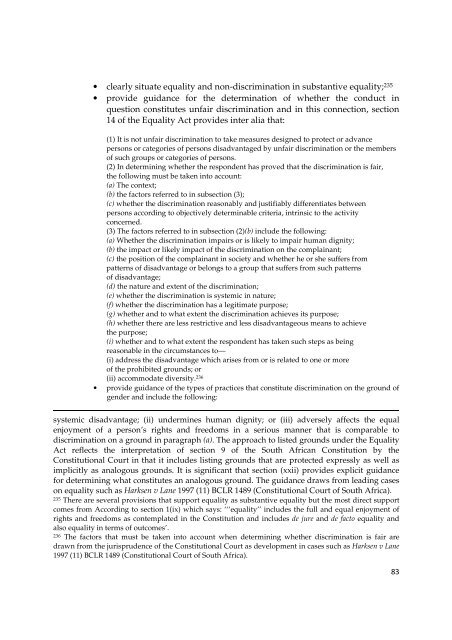sexual health and human rights in the african region - The ICHRP
sexual health and human rights in the african region - The ICHRP
sexual health and human rights in the african region - The ICHRP
Create successful ePaper yourself
Turn your PDF publications into a flip-book with our unique Google optimized e-Paper software.
• clearly situate equality <strong>and</strong> non-discrim<strong>in</strong>ation <strong>in</strong> substantive equality; 235<br />
• provide guidance for <strong>the</strong> determ<strong>in</strong>ation of whe<strong>the</strong>r <strong>the</strong> conduct <strong>in</strong><br />
question constitutes unfair discrim<strong>in</strong>ation <strong>and</strong> <strong>in</strong> this connection, section<br />
14 of <strong>the</strong> Equality Act provides <strong>in</strong>ter alia that:<br />
(1) It is not unfair discrim<strong>in</strong>ation to take measures designed to protect or advance<br />
persons or categories of persons disadvantaged by unfair discrim<strong>in</strong>ation or <strong>the</strong> members<br />
of such groups or categories of persons.<br />
(2) In determ<strong>in</strong><strong>in</strong>g whe<strong>the</strong>r <strong>the</strong> respondent has proved that <strong>the</strong> discrim<strong>in</strong>ation is fair,<br />
<strong>the</strong> follow<strong>in</strong>g must be taken <strong>in</strong>to account:<br />
(a) <strong>The</strong> context;<br />
(b) <strong>the</strong> factors referred to <strong>in</strong> subsection (3);<br />
(c) whe<strong>the</strong>r <strong>the</strong> discrim<strong>in</strong>ation reasonably <strong>and</strong> justifiably differentiates between<br />
persons accord<strong>in</strong>g to objectively determ<strong>in</strong>able criteria, <strong>in</strong>tr<strong>in</strong>sic to <strong>the</strong> activity<br />
concerned.<br />
(3) <strong>The</strong> factors referred to <strong>in</strong> subsection (2)(b) <strong>in</strong>clude <strong>the</strong> follow<strong>in</strong>g:<br />
(a) Whe<strong>the</strong>r <strong>the</strong> discrim<strong>in</strong>ation impairs or is likely to impair <strong>human</strong> dignity;<br />
(b) <strong>the</strong> impact or likely impact of <strong>the</strong> discrim<strong>in</strong>ation on <strong>the</strong> compla<strong>in</strong>ant;<br />
(c) <strong>the</strong> position of <strong>the</strong> compla<strong>in</strong>ant <strong>in</strong> society <strong>and</strong> whe<strong>the</strong>r he or she suffers from<br />
patterns of disadvantage or belongs to a group that suffers from such patterns<br />
of disadvantage;<br />
(d) <strong>the</strong> nature <strong>and</strong> extent of <strong>the</strong> discrim<strong>in</strong>ation;<br />
(e) whe<strong>the</strong>r <strong>the</strong> discrim<strong>in</strong>ation is systemic <strong>in</strong> nature;<br />
(f) whe<strong>the</strong>r <strong>the</strong> discrim<strong>in</strong>ation has a legitimate purpose;<br />
(g) whe<strong>the</strong>r <strong>and</strong> to what extent <strong>the</strong> discrim<strong>in</strong>ation achieves its purpose;<br />
(h) whe<strong>the</strong>r <strong>the</strong>re are less restrictive <strong>and</strong> less disadvantageous means to achieve<br />
<strong>the</strong> purpose;<br />
(i) whe<strong>the</strong>r <strong>and</strong> to what extent <strong>the</strong> respondent has taken such steps as be<strong>in</strong>g<br />
reasonable <strong>in</strong> <strong>the</strong> circumstances to—<br />
(i) address <strong>the</strong> disadvantage which arises from or is related to one or more<br />
of <strong>the</strong> prohibited grounds; or<br />
(ii) accommodate diversity. 236<br />
• provide guidance of <strong>the</strong> types of practices that constitute discrim<strong>in</strong>ation on <strong>the</strong> ground of<br />
gender <strong>and</strong> <strong>in</strong>clude <strong>the</strong> follow<strong>in</strong>g:<br />
systemic disadvantage; (ii) underm<strong>in</strong>es <strong>human</strong> dignity; or (iii) adversely affects <strong>the</strong> equal<br />
enjoyment of a person’s <strong>rights</strong> <strong>and</strong> freedoms <strong>in</strong> a serious manner that is comparable to<br />
discrim<strong>in</strong>ation on a ground <strong>in</strong> paragraph (a). <strong>The</strong> approach to listed grounds under <strong>the</strong> Equality<br />
Act reflects <strong>the</strong> <strong>in</strong>terpretation of section 9 of <strong>the</strong> South African Constitution by <strong>the</strong><br />
Constitutional Court <strong>in</strong> that it <strong>in</strong>cludes list<strong>in</strong>g grounds that are protected expressly as well as<br />
implicitly as analogous grounds. It is significant that section (xxii) provides explicit guidance<br />
for determ<strong>in</strong><strong>in</strong>g what constitutes an analogous ground. <strong>The</strong> guidance draws from lead<strong>in</strong>g cases<br />
on equality such as Harksen v Lane 1997 (11) BCLR 1489 (Constitutional Court of South Africa).<br />
235 <strong>The</strong>re are several provisions that support equality as substantive equality but <strong>the</strong> most direct support<br />
comes from Accord<strong>in</strong>g to section 1(ix) which says: ‘‘‘equality’’ <strong>in</strong>cludes <strong>the</strong> full <strong>and</strong> equal enjoyment of<br />
<strong>rights</strong> <strong>and</strong> freedoms as contemplated <strong>in</strong> <strong>the</strong> Constitution <strong>and</strong> <strong>in</strong>cludes de jure <strong>and</strong> de facto equality <strong>and</strong><br />
also equality <strong>in</strong> terms of outcomes’.<br />
236 <strong>The</strong> factors that must be taken <strong>in</strong>to account when determ<strong>in</strong><strong>in</strong>g whe<strong>the</strong>r discrim<strong>in</strong>ation is fair are<br />
drawn from <strong>the</strong> jurisprudence of <strong>the</strong> Constitutional Court as development <strong>in</strong> cases such as Harksen v Lane<br />
1997 (11) BCLR 1489 (Constitutional Court of South Africa).<br />
83
















